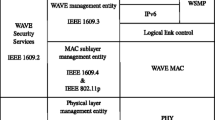Abstract
Contention-based forwarding (CBF) is a broadcasting technique used to disseminate emergency messages for traffic safety applications in intelligent transportation systems. Its design hypotheses have however been based on three major assumptions: uniform vehicular topology, nonfading channels and homogeneous communication capabilities. Realistic vehicular urban topologies do not comply with any of them, making CBF select relays, which may not exist, may not be reached or may not be optimal due to heterogeneous transmit capabilities. In this paper, we propose to adapt CBF to such challenging environment by first employing two different mechanisms as a function of the topology and second by considering the dissemination capabilities of the relays, allowing for example road-side units or tall vehicles to preferably act as relays when necessary. Our protocol, called Bi-Zone Broadcast, is evaluated in a realistic urban environment and showed to provide around 46 % improvement in dissemination delay and 40 % reduction in overhead compared to plain CBF or flooding. We finally shed light to other aspects of CBF that remain unsolved and should be addressed in future work to further improve the reliability of dissemination protocols for traffic safety protocols.






















Similar content being viewed by others
References
Akkhara P, Sekiya Y, Wakahara Y (2009) Efficient alarm messaging by multi-channel cut-through rebroadcasting based on inter-vehicle communication. In: Proc. of the IAENG journal of computer science (IJCS)
ALshaer H, Horlai E (2005) An optimized adaptive broadcast scheme for inter-vehicle communication. In: Proc. of the 61st vehicular technology conference (VTC’05)
Benslimane A (2004) Optimized dissemination of alarm messages in vehicular ad-hoc networks (VANET). In: Proc. of the 7th IEEE international conference on high speed networks and multimedia communications (HSNMC’04)
Blaszczyszyn B, Laouiti A, Muhlethaler P, Toor Y (2008) Opportunistic broadcast in vanets (ob-van) using active signaling for relays selection. In: Proc. of the 8th intelligent transport systems telecommunications(ITST’08)
Bononi L, Felice, MD (2007) A cross layered mac and clustering scheme for efficient broadcast in vanets. In: Proc. of the IEEE International conference on mobile ad hoc and sensor systems (MASS’07)
Briesemeister L, Schafers L , Hommel G (2000) Disseminating messages among highly mobile hosts based on intervehicle communication. In: Proc. of the IEEE intelligent vehicles symposium
Chen W, Chennikara-Varghese J, Lee J, Cai S, Hikita T (2006) Dynamic local peer group organizations for vehicle communications. In: Proc. of the second international workshop on vehicle-to-vehicle communications (V2VCOM’06)
Durresi M, Durresi A, Barolli L (2005) Emergency broadcast protocol for inter-vehicle communications. In: Proc. of the 11th international conference on parallel and distributed systems (ICPADS’05)
Eichler S, Schroth C (2007) A multi-layer approach for improving the scalability of vehicular ad-hoc networks. In: Proc. of the conference on communication in distributed systems (KiVS’07), Workshop: 4th workshop on mobile ad hoc networks (WMAN’07)
Eichler S, Schroth C, Koscht T, Strassbergert, M (2006) Strategies for context-adaptive message dissemination in vehicular ad hoc networks. In: Proc. of the second international workshop on vehicle-to-vehicle communications (V2VCOM’06)
Fasolo E, Furiato R, Zanella A (2005) Smart Broadcast algorithm for inter-vehicular communications. In: Proc. of the wireless personal multimedia communication (WPMC’05)
Füßler H, Hartenstein H, Widmer J, Mauve M, Effelsberg W (2004) Contention-based forwarding for street scenarios. In: Proc. of the 1st international workshop on intelligent transportation (WIT’04)
GeoNet project. http://www.geonet-project.eu/. Accessed March 2011
Hrizi F, Filali F (2009) On congestion-aware broadcasting in V2X networks. In: Proc. of the 2nd international workshop on communication technologies for vehicles (Nets4Cars’09)
iTETRIS project. http://www.ict-itetris.eu/10-10-10-community/. Accessed June–July 2011
Jiang H, Guo H, Chen L (2008) Reliable and efficient alarm message routing in vanet. In: Proc. of the 5th 28th international conference on distributed computing systems workshops
Khakbaz S, Fathy M (2008) A reliable method for disseminating safety information in vehicular ad hoc networks considering fragmentation problem. In: Proc. of the fourth international conference on wireless and mobile communications (ICWMC’08)
Korkmaz G, Ekici E (2004) Urban multi-hop broadcast protocol for inter-vehicle communication systems. In: Proc. of the 1st ACM workshop on vehicular ad hoc networks (VANET’04)
Mariyasagayam MN, Osafune T, Lenardi M (2007) Enhanced multi-hop vehicular broadcast (MHVB) for active safety applications. In: Proc. of the 7th international conference on ITS telecommunications (ITST’07)
Ni S-Y, Tseng Y-C, Chen Y-S, Sheu J-P (1999) The broadcast storm problem in a mobile ad hoc network. In: Proc. of the 5th annual ACM/IEEE international conference on mobile computing and networking
ns-3 simulator. http://www.nsnam.org/. Accessed June–July 2011
Palazzi CE, Ferretti S, Roccetti M, Pau G, Gerla M (2007) How do you quickly choreograph inter-vehicular communications? A fast vehicle-to-vehicle multi-hop broadcast algorithm, explained. In: Proc. of the 4th IEEE consumer communications and networking conference (CCNC’07)
Ros FJ, Ruiz PM, Stojmenovic I (2009) Reliable and efficient broadcasting in vehicular ad hoc networks. In: Proc. of the 69th vehicular technology conference (VTC’2009)
Ros FJ, Ruiz PM, Stojmenovic I (2010) Acknowledgment-based broadcast protocol for reliable and efficient data dissemination in vehicular ad-hoc network. In: Proc. of the the IEEE transactions on mobile computing
SUMO simulator. http://sumo.sourceforge.net/. Accessed June–July 2011
Torrent-Moreno M (2007) Inter-vehicle communications: achieving safety in a distributed wireless environment—challenges, systems and protocols. Ph.D. thesis, University of Karlsruhe
Torrent-Moreno M (2007) Inter-vehicle communications: assessing information dissemination under safety constraints. In: Proc. of the 4th annual IEEE/IFIP conference on wireless on demand network systems and services (WONS)
Acknowledgements
This research was supported in part by the iTETRIS European project (contract no. FP7-224644), in part by the SCORE@F project and by EURECOM industrial members : BMW Group, Cisco, Monaco Telecom, Orange, SAP, SFR, Sharp, STEricsson, Swisscom, Symantec and Thales.
Author information
Authors and Affiliations
Corresponding author
Rights and permissions
About this article
Cite this article
Hrizi, F., Bonnet, C., Härri, J. et al. Adapting contention-based forwarding to urban vehicular topologies for active safety applications. Ann. Telecommun. 68, 267–285 (2013). https://doi.org/10.1007/s12243-012-0320-0
Received:
Accepted:
Published:
Issue Date:
DOI: https://doi.org/10.1007/s12243-012-0320-0




